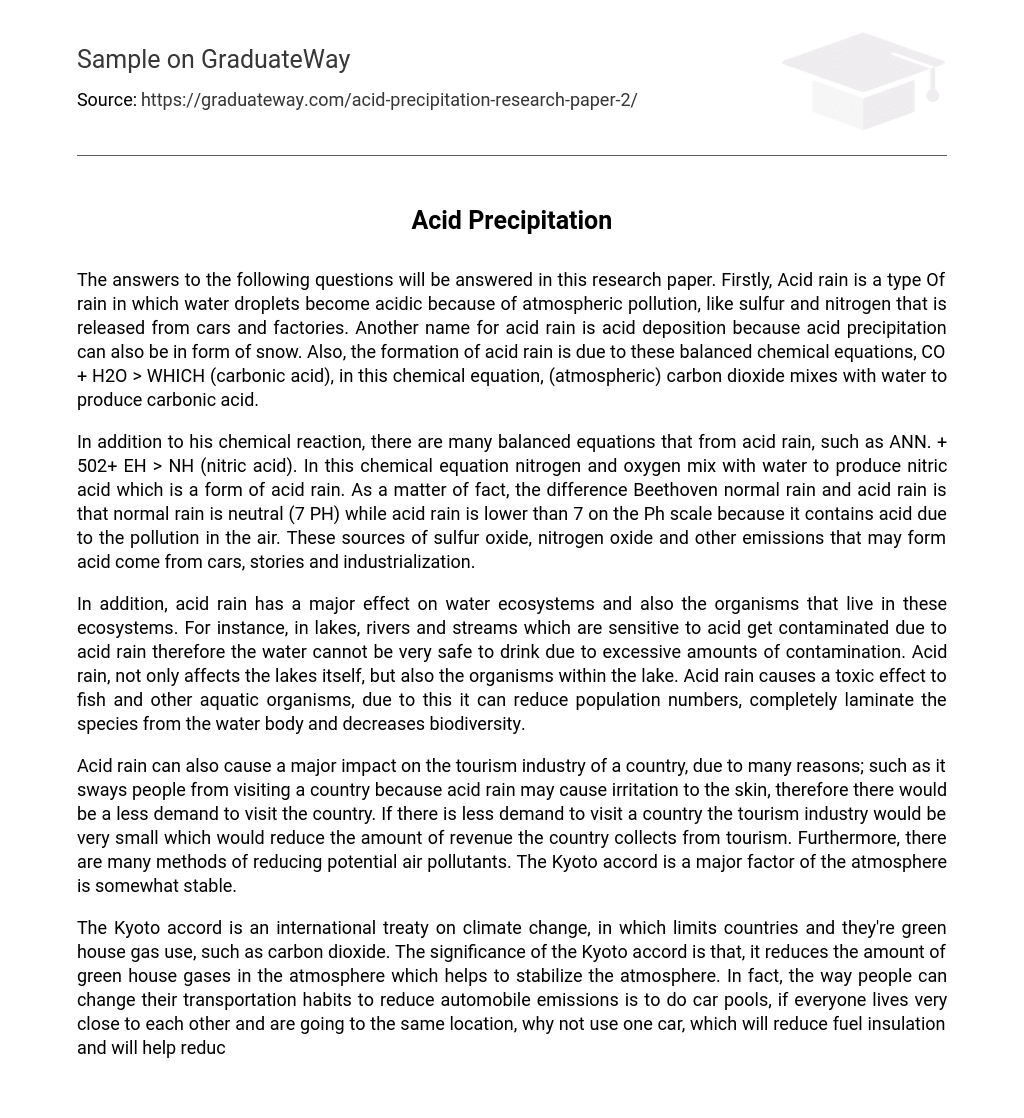The answers to the following questions will be answered in this research paper. Firstly, Acid rain is a type Of rain in which water droplets become acidic because of atmospheric pollution, like sulfur and nitrogen that is released from cars and factories. Another name for acid rain is acid deposition because acid precipitation can also be in form of snow. Also, the formation of acid rain is due to these balanced chemical equations, CO + H2O > WHICH (carbonic acid), in this chemical equation, (atmospheric) carbon dioxide mixes with water to produce carbonic acid.
In addition to his chemical reaction, there are many balanced equations that from acid rain, such as ANN. + 502+ EH > NH (nitric acid). In this chemical equation nitrogen and oxygen mix with water to produce nitric acid which is a form of acid rain. As a matter of fact, the difference Beethoven normal rain and acid rain is that normal rain is neutral (7 PH) while acid rain is lower than 7 on the Ph scale because it contains acid due to the pollution in the air. These sources of sulfur oxide, nitrogen oxide and other emissions that may form acid come from cars, stories and industrialization.
In addition, acid rain has a major effect on water ecosystems and also the organisms that live in these ecosystems. For instance, in lakes, rivers and streams which are sensitive to acid get contaminated due to acid rain therefore the water cannot be very safe to drink due to excessive amounts of contamination. Acid rain, not only affects the lakes itself, but also the organisms within the lake. Acid rain causes a toxic effect to fish and other aquatic organisms, due to this it can reduce population numbers, completely laminate the species from the water body and decreases biodiversity.
Acid rain can also cause a major impact on the tourism industry of a country, due to many reasons; such as it sways people from visiting a country because acid rain may cause irritation to the skin, therefore there would be a less demand to visit the country. If there is less demand to visit a country the tourism industry would be very small which would reduce the amount of revenue the country collects from tourism. Furthermore, there are many methods of reducing potential air pollutants. The Kyoto accord is a major factor of the atmosphere is somewhat stable.
The Kyoto accord is an international treaty on climate change, in which limits countries and they’re green house gas use, such as carbon dioxide. The significance of the Kyoto accord is that, it reduces the amount of green house gases in the atmosphere which helps to stabilize the atmosphere. In fact, the way people can change their transportation habits to reduce automobile emissions is to do car pools, if everyone lives very close to each other and are going to the same location, why not use one car, which will reduce fuel insulation and will help reduce the amount of pollution that goes into the atmosphere.
Another way to help reduce automobile emission is to make hybrid cars, which do not use as much gas as other cars do and also these cars run on electricity, if you are under 60 km/ hrs. Likewise, there are various methods of reducing oxides of sulfur emissions from various sources. There are 3 classes of reducing oxides of sulfur emissions, by pre combustion methods, combustion method and post combustion methods. Pre combustion methods include coal switching and coal cleaning. The most efficient combustion method is an atmospheric fulfilled bed.
It has the ability to remove 90% of ASS emissions, but it comes with a high operating cost. The two post combustion processes are absorption and adsorption. By using these methods, factories can reduce oxides of sulfur emissions. Moreover, a catalytic converter is also a device used to reduce emissions of potential air pollutants and is a device used to reduce the harmful emissions from an internal combustion engine. Catalytic converters are used in exhaust systems to provide a place for the oxidation and reduction of toxic by rodents of fuel into less dangerous substances for the environment.
Catalytic converters include two types of catalysts, which are reduction catalyst and an oxidation catalyst. These types are consisted of a ceramic structure coated with a metal catalyst usually platinum; rhodium and palladium [see Figure 1 and 2]. These coatings expose the maximum surface area of catalyst to the exhaust stream. Similarly, the purpose of removing sulfur from hydrocarbon fuels is to reduce the sulfur dioxide emissions that result in using those fuels in automotive vehicles.





